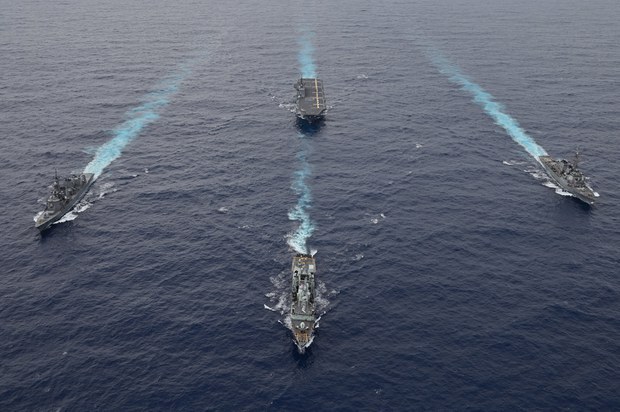China’s growing assertiveness against other claimant states in the South China Sea, and Japan in the East China Sea presents a “grave concern for Japan,” according to a report by the ISEAS-Yusof Ishak Institute in Singapore.
So a combined naval exercise led by Japan n the South China Sea is seen as a display of allied solidarity amid increased regional tensions.
A week-long exercise involving maritime forces from Canada, Japan, and the United States ended Sunday. It was held off the back of another trilateral exercise, Noble Raven 22, which concluded in the Western Pacific a month earlier.
The drills, dubbed Noble Raven 22-2, saw the rare appearance of a Japanese submarine that may signal a future deployment of Japan’s subs in the region. This is only the second time a Japanese submarine has taken part in joint drills in the South China Sea. The first was in November 2021, in a bilateral exercise with the U.S. Navy.
Strengthening our #NavyPartnerships! 💪 ⚓
— U.S. Navy (@USNavy) October 7, 2022
Sailors aboard #USSBenfold work with @jmsdf_pao_eng and #ROKNavy personnel during an anti-submarine warfare exercise in the Waters East of the Korean Peninsula.
📸 : by MC2 Arthur Rosen pic.twitter.com/2d5uebR5Zs
Maritime forces from Canada, Japan and the United States concluded exercises in the South China Sea Oct. 1, demonstrating a shared commitment to a free and open Indo-Pacific, said Commander, Task Force 71/Destroyer Squadron 15 Public Affairs.
The Japan Maritime Self-Defense Force (JMSDF) led the exercise in support of their Indo-Pacific deployment,

The exercises included JMSDF’s JS Izumo (DDH 183) and JS Takanami (DD 110). The multi-lateral training for the three maritime forces served to strengthen skills in maritime operations, anti-submarine warfare operations, air warfare operations, live-fire missile events, and advanced maneuvering scenarios.
“Through increased practical exercise, together we improved tactical capabilities and interoperability between the JMSDF, the U.S. Navy and the Royal Canadian Navy, and we promoted cooperative relationship of Japan-U.S.-Canadian naval forces in order to realize a free and open Indo-Pacific,” said Rear Adm. Hirata Toshiyuki, commanding officer of Escort Flotilla 4.
Representing the U.S. Navy was Arleigh Burke-class guided-missile destroyer USS Higgins (DDG 76) and fleet replenishment-oiler USNS Rappahannock (T-AO 204).
It didn’t go down well. North Korea decided to lob a missile over Japan.
#Japan's MOD map of #NorthKorea's Hwasong-12 intermediate-range ballistic missile launch on Oct. 4th
— Indo-Pacific News – Geo-Politics & Military News (@IndoPac_Info) October 5, 2022
The longest range missile tested so far by N. Korea.
Japanese air raid warning systems kicked in & people took shelter.
Range: 4,600 km
Apogee: 1,000 km
Flight time: 22 minutes pic.twitter.com/1czbgvL3Pt
So, SoKo and the US responded. If this doesn’t all smack of escalation in the South China sea, what does?
South Korea and the United States conducted a precision bombing exercise in response to North Korea's launch of a ballistic missile over Japan on Tuesday, South Korea’s Joint Chiefs of Staff (JCS) announced in a statement.
— Kylie Atwood (@kylieatwood) October 4, 2022
